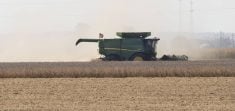Reuters – Farmers in the world’s top pork market have lost money for most of this year due to low prices and high feed costs, and the trend is likely to continue.
China’s pig production is still growing, a farm ministry official said Oct. 23, and a higher-than-normal number of breeding sows is set to maintain downward pressure on prices.
China had 42.4 million sows at the end of September, unchanged from the previous month, and 3.4 per cent higher than the normal level, Chen Guanghua, head of the animal husbandry and veterinary bureau at the Ministry of Agriculture and Rural Affairs, said at a press briefing.
Read Also

Riding market swings can add farm profit
Regular price trends in the grain market can help farmers pinpoint how and when to sell their grain with more confidence, analyst says
Production efficiency of sows is also improving, with each sow breeding 0.5 more piglets compared to the previous year.
Chen added that, while prices may rebound in the fourth quarter, which is the peak consumption season, “there is no basis for a sharp rise.”
Farmers have increasingly raised pigs to heavier weights, which will add to November supply, said Chen.
Supply could increase after the Chinese New Year in February, when there could be a decline in consumption as well as an increase in slaughter volumes.
“The level of pig losses may even be greater than that of the same period this year,” he said, urging farmers to adjust their production.
China’s grain output is also set to grow, thanks to an expected additional 1.15 million acres planted with autumn crops, said Pan Wenbo, director of the planting industry management department, also speaking at the briefing.
Total autumn grain acreage is set to reach the equivalent of 214.98 million acres, he said.
The increase is due to switching from cash crops to grain, as well as more intercropping and some land being returned to farming, he said.















